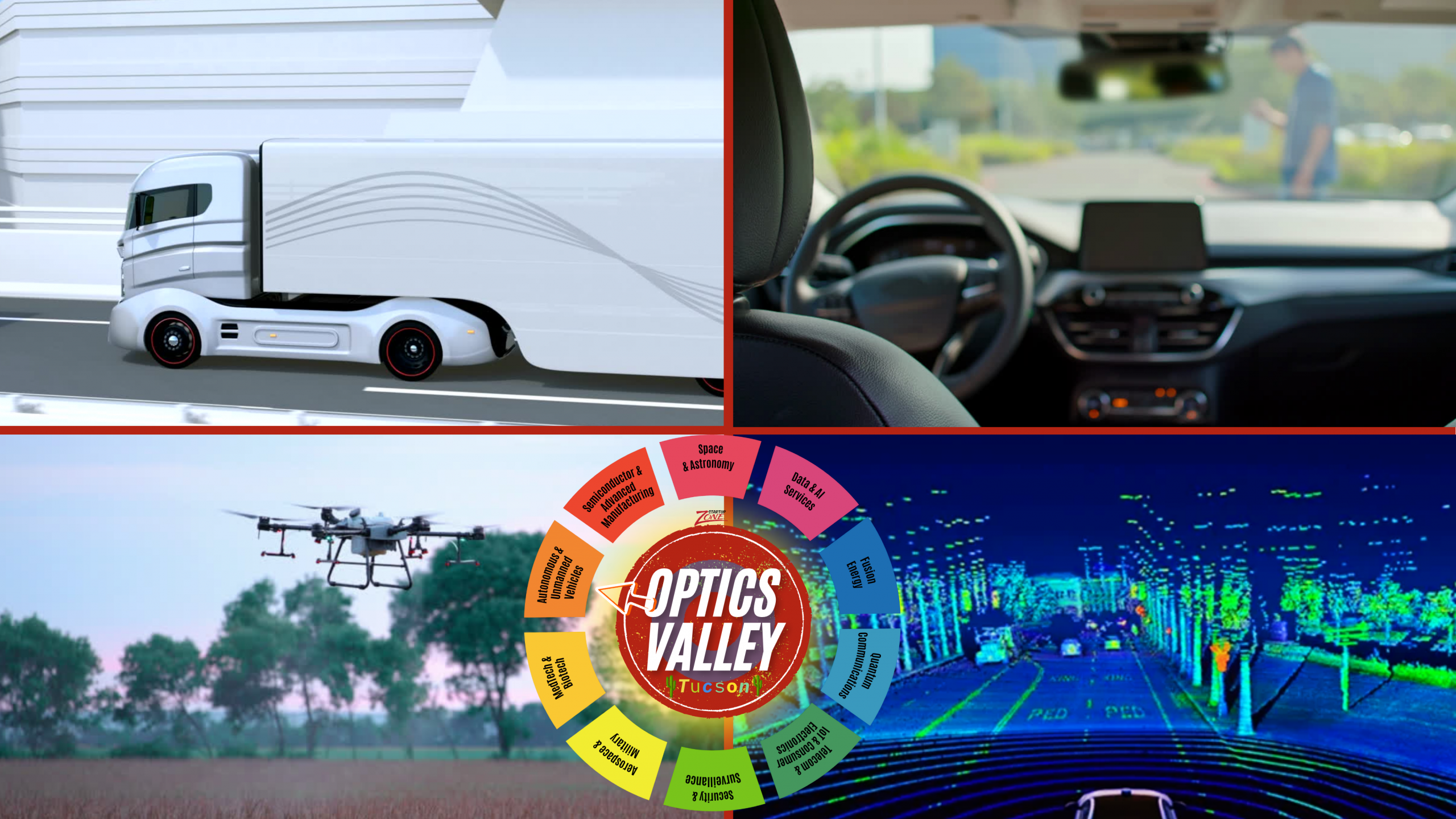Autonomous and Unmanned Vehicles Can See
Because Optics Valley Enables it
A small part of a $1T global market (by 2030), autonomous and unmanned systems rapidly transform mobility and operations across sectors, whether navigating crowded urban streets, flying reconnaissance missions in airspace, mapping ocean floors, or hauling ore through underground tunnels. Behind the scenes of these self-directed platforms are the real stars of autonomy: optics and photonics.
From advanced LiDAR and hyperspectral imaging to fiber-optic navigation and laser-based gas sensing, optics and photonics provide the “sight” and sensory intelligence that allow machines to operate safely, precisely, and independently, even in GPS-denied, dark, or dangerous environments.
This article12 will explore the critical optical and photonics technologies powering unmanned systems in four domains: land, air, ocean, and underground mining. I’ll highlight the light sources, optics, detectors, and laser systems enabling this vision-driven revolution.
Autonomous Ground Vehicles (Streets and Highways)
Self-driving cars, delivery bots, and autonomous freight haulers rely on a multi-modal optical sensor suite that enables real-time perception, mapping, and navigation.
Key Technologies:
- LiDAR (Light Detection and Ranging)
- Light Source: Eye-safe pulsed or continuous-wave lasers (typically 905 nm or 1550 nm).
- Optics: Beam steering mirrors (mechanical or MEMS-based), diffractive optics for fan beams.
- Receiver: Avalanche photodiodes (APDs) or Single-photon avalanche diodes (SPADs).
- Use: Generates high-resolution 3D point clouds for object detection, road mapping, and obstacle avoidance.
- Cameras (Visible, Stereo, IR, Polarized)
- Light Source: Ambient light or active NIR illumination (850–940 nm).
- Optics: High-quality lenses, polarizers, and wide dynamic range sensors.
- Receiver: CMOS or CCD image sensors.
- Use: Road sign recognition, lane detection, object classification, low-light vision.
- Infrared and Thermal Cameras
- Light Source: Passive detection of thermal IR emissions.
- Optics: Germanium or chalcogenide glass lenses.
- Receiver: Microbolometers or InGaAs detectors.
- Use: Night driving, animal/human detection, fog penetration.
- Optical Inertial Navigation (FOG)
- Light Source: Coherent laser source (often HeNe or diode lasers).
- Optics: Fiber-optic coil (Sagnac loop).
- Receiver: Photodetector measuring phase shift.
- Use: GPS-denied navigation and localization in urban canyons.
- Vehicle-to-Everything (V2X) Optical Comms
- Light Source: Laser diodes or VCSELs (Vertical Cavity Surface Emitting Lasers).
- Receiver: PIN photodiodes, APDs.
- Use: Ultra-low latency, high-speed data transfer between AVs and infrastructure.
Unmanned Aerial Vehicles (Airspace)
From small drones to fixed-wing surveillance aircraft, UAVs operate in fast-changing environments and depend heavily on lightweight optical systems for navigation, mapping, and analysis.
Key Technologies:
- Miniaturized LiDAR
- Light Source: Pulsed diode lasers at 905 nm or 1550 nm.
- Optics: MEMS scanners, wide-angle lenses, waveguides.
- Receiver: APDs or SPAD arrays.
- Use: Terrain following, tree canopy mapping, obstacle avoidance.
- Visual-Inertial Odometry
- Light Source: Ambient light with IMU synchronization.
- Optics: Stereo or monocular camera setups.
- Receiver: CMOS sensors.
- Use: Real-time tracking of drone position without GPS.
- Hyperspectral and Multispectral Imaging
- Light Source: Sunlight or onboard broadband sources (xenon or halogen lamps).
- Optics: Diffraction gratings, tunable filters, beam splitters.
- Receiver: Scientific-grade CCD or CMOS arrays.
- Use: Precision agriculture, target detection, mineral surveying, pollution monitoring.
- Free-Space Optical (FSO) Communications
- Light Source: Modulated laser beams (850 to 1550 nm).
- Optics: Beam collimators, adaptive optics.
- Receiver: High-speed photodiodes.
- Use: High-bandwidth telemetry from drone to ground station.
Autonomous Underwater Vehicles (Ocean)
Underwater autonomy is one of the most challenging environments for photonics due to poor visibility and high pressure. Yet optical systems are essential for high-resolution inspection and navigation.
Key Technologies:
- Laser Line Scanners (LLS)
- Light Source: Blue-green lasers (~488–532 nm) for better penetration in seawater.
- Optics: Cylindrical lenses or galvo mirrors to project line patterns.
- Receiver: CCD/CMOS cameras synced to scan.
- Use: Subsea asset inspection, shipwreck exploration, marine archeology.
- Structured Light Imaging
- Light Source: Projected pattern using LED or laser projector (blue-green).
- Optics: Diffractive optical elements to shape the beam.
- Receiver: High-sensitivity underwater cameras.
- Use: 3D reconstruction of seabeds or structures.
- Laser Spectroscopy for Water Quality Monitoring
- Light Source: Tunable diode lasers or Raman excitation lasers.
- Optics: Fiber probes, filters, beam combiners.
- Receiver: Photomultiplier tubes (PMTs), InGaAs detectors.
- Use: Detection of dissolved gases, hydrocarbons, or biological activity.
- Fiber-Optic Tethered Video Systems (ROVs)
- Light Source: High-lumen LEDs for illumination.
- Optics: Wide-angle underwater lenses.
- Receiver: High-definition cameras, transmitted via optical fiber.
- Use: Live inspection and manipulation of subsea infrastructure.
- Fiber-Optic Gyroscopes
- Light Source: Coherent laser source in looped fiber.
- Use: Navigation without GPS in deep-sea environments.
Unmanned Systems in Mining
Autonomous systems increase safety and efficiency in mining, especially in dangerous or confined underground conditions. Optical sensing systems must be robust to dust, vibration, and low lighting.
Key Technologies:
- Time-of-Flight (ToF) Sensors and LiDAR
- Light Source: Pulsed NIR lasers (~850–940 nm).
- Optics: Collimating lenses, micro-mirror arrays.
- Receiver: SPADs or CMOS ToF arrays.
- Use: Navigating tunnels, mapping mine walls, and avoiding collisions.
- 3D Structured Light Projectors
- Light Source: Patterned laser diode or LED arrays.
- Optics: Custom diffractive or refractive optics.
- Receiver: CMOS cameras to interpret light deformation.
- Use: Geological mapping, cavity monitoring, robotic drilling alignment.
- Thermal and Low-Light Cameras
- Light Source: Passive (IR) or active NIR illuminators.
- Optics: Germanium optics for IR, wide-aperture lenses.
- Receiver: Thermopile or microbolometer arrays.
- Use: Detecting human presence, hot zones in machinery, and flame detection.
- Laser-Based Gas Detection (TDLAS)
- Light Source: Tunable diode lasers.
- Optics: Gas absorption cells, wavelength filters.
- Receiver: Sensitive photodetectors tuned to gas absorption lines.
- Use: Detecting methane or explosive gases in real-time.
- Distributed Fiber-Optic Sensors
- Light Source: Pulsed laser launched into optical fiber.
- Optics: Scattering-based sensing via Rayleigh/Brillouin/Raman effects.
- Receiver: Optical time-domain reflectometers (OTDR).
- Use: Sensing vibration, temperature, or strain along the tunnel walls.
Cross-Sector Technologies: What They Share
Many enabling technologies are used across all domains of autonomy, adapted to environmental and mission-specific needs.

What’s Next: Photonic Convergence & Miniaturization
The future of autonomous systems lies in the integration of multiple optical modalities, AI edge processing, and photonic chips:
- Photonic Integrated Circuits (PICs): Shrinking laser sources, beam steering, and sensors onto single chips for drones and bots.
- Sensor Fusion Platforms: Real-time fusion of LiDAR, IR, and camera data using AI to interpret complex scenes.
- Quantum Photonics: Quantum-based gyroscopes and encrypted optical comms for secure, GPS-independent navigation.
Conclusion: Autonomy Needs Vision… And Vision Needs Light
Autonomous systems are only as good as their sensors across every terrain, roadway, sky, seafloor, and mine shaft. And at the heart of those sensors are optics and photonics.
From pulsed lasers that map the world to hyperspectral imagers that see the unseen, these technologies give unmanned systems the power to operate with awareness, precision, and safety.
As Optics Valley continues to innovate, the future of autonomy will be defined not just by silicon and software, but by glass, light, and photonic intelligence.
The challenges continue to be commercialization and supply chain readiness. Even the best technology won’t scale without a viable optics, detectors, and integration know-how supply chain. We must continue working on Optics Valley’s manufacturing readiness, precision optics suppliers, precision machining, and local systems integrators to make it more actionable for Arizona-based commercialization. We also need to work with strategic global players in the same way.
- Although I’m an electrical engineer, I’m not an expert in all of these referenced technologies or applications. ↩︎
- I have not taken the time to explain these technologies in layperson’s terms. These were written to help expose you to the breadth and depth of innovations that are often developed locally in Optics Valley (Tucson, AZ). ↩︎








